Cohomogeneity one Ricci solitons
Abstract
Abstract: Ricci solitons are genralizations of Einstein metrics which have become subject of much interest over the last decade. In this talk I will give a basic introduction to these metrics and discuss how to reformulate the Ricci soliton equation as a Hamiltonian system assuming some symmetry conditions. Using this approach we will construct explicit solutions to the soliton equation for manifolds of dimension 5.
Occurrence detection, correlation and classification among large numbers of time series
Abstract
Markit is a leading global provider of financial information services. We provide products that enhance transparency, reduce risk and improve operational efficiency.
We wish to find ways to automatically detect and label ‘extreme’ occurrences in a time series such as structural breaks, nonlinearities, and spikes (i.e. outliers). We hope to detect these occurrences in the levels, returns and volatility of a time series or any other transformation of it (e.g. moving average).
We also want to look for the same types of occurrences in the multivariate case in a set of time series through measures such as e.g. correlations, eigenvalues of the covariance matrix etc. The number of time series involved is of the order 3x10^6.
We wish to explain the appearance of an ‘extreme’ occurrence or a cluster of occurrences endogenously, as an event conditional on the values of the time series in the set, both contemporaneously and/or as conditional on their time lags.
Furthermore, we would like to classify the events that caused the occurrence in some major categories, if found e.g. shock to oil supply, general risk aversion, migrations etc. both algorithmically and by allowing human corrective judgement (which could become the basis for supervised learning).
Marginal deformations of N=1 SCFT's and generalised geometry
Abstract
Generalised Geometry is a very powerful tool to study gravity duals of strongly coupled gauge theories. In this talk I will discuss how Exceptional Geometry can be used to study marginal deformations of N=1 SCFT's in 4 and 3 dimensions.
Universal thickening of C_p
Abstract
This is the 4th talk of the study group on Beilinson's approach to p-adic Hodge theory, following the notes of Szamuley and Zabradi.
I shall finish the computation of the module of differentials of the ring of integers of the algebraic closure of Q_p and describe a universal thickening of C_p.
I shall also quickly introduce the derived de Rham algebra. Kevin McGerty will give a talk on the derived de Rham algebra in W5 or W6.
Residual properties of amalgams
Abstract
I will discuss the circumstances in which residual finiteness properties of an amalgamated free product $A\ast_c B$ may be deduced from the properties of $A$ and $B$, with particular regard to the pro-p residual properties.
Number theory tools for Cryptographic Applications
Abstract
In this lecture we describe the effective Chebotarev Theorem for global function fields and show how this can be used to describe the statistics of a polynomial map f in terms of its monodromy groups. With this tool in hand, we will provide a strategy to remove the remaining heuristic in the quasi-polynomial time algorithm for discrete
logarithm problems over finite fields of small characteristic.
On the null string origin of the ambitwistor strings
Abstract
The CHY formulae are a set of remarkable formulae describing the scattering amplitudes of a variety of massless theories, as certain worldsheet integrals, localized on the solutions to certain polynomial equations (scattering equations). These formulae arise from a new class of holomorphic strings called Ambitwistor strings that encode exactly the dynamics of the supergravity (Yang-Mills) modes of string theory. Despite some recent progress by W. Siegel and collaborators, it remains as an open question as to what extent this theory was connected to the full string theory. The most mysterious point being certainly that the localization equations of the ambitwistor string also appear in the zero tension limit of string theory (alpha’ to infinity), which is the opposite limit than the supergravity one (alpha’ to zero). In this talk, I’ll report on some work in progress with E. Casali (Math. Inst. Oxford) and argue that the ambitwistor string is actually a tensionless string. Using some forgotten results on the quantization of these objects, we explain that the quantization of tensionless strings is ambiguous, and can lead either to a higher spin theory, or to the ambitwistor string, hence solving the previously mentioned paradox. In passing, we see that the degenerations of the tensile worldsheet that lead to tensionless strings make connection with Galilean Conformal Algebras and the (3d) BMS algebra.
11:00


